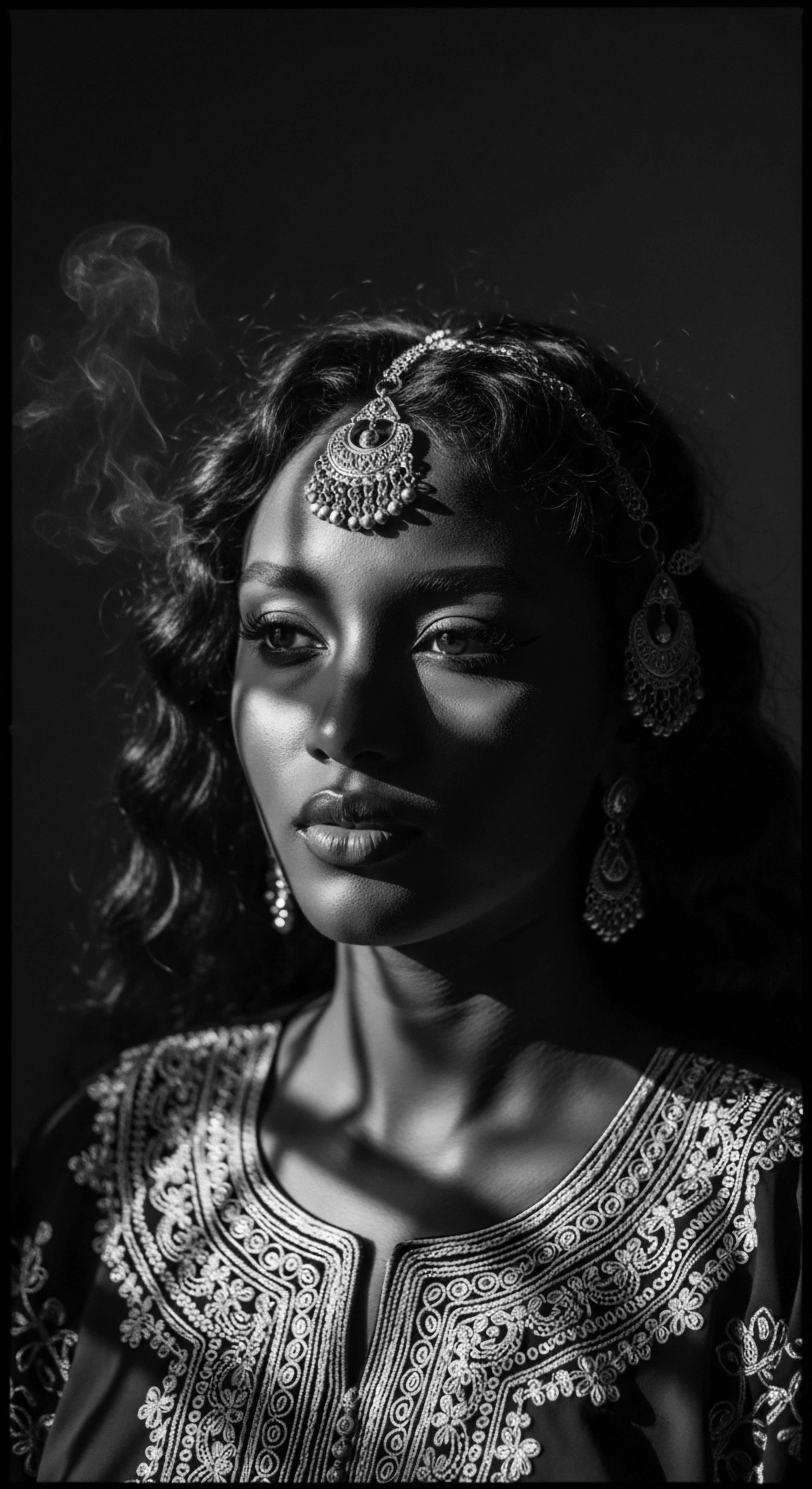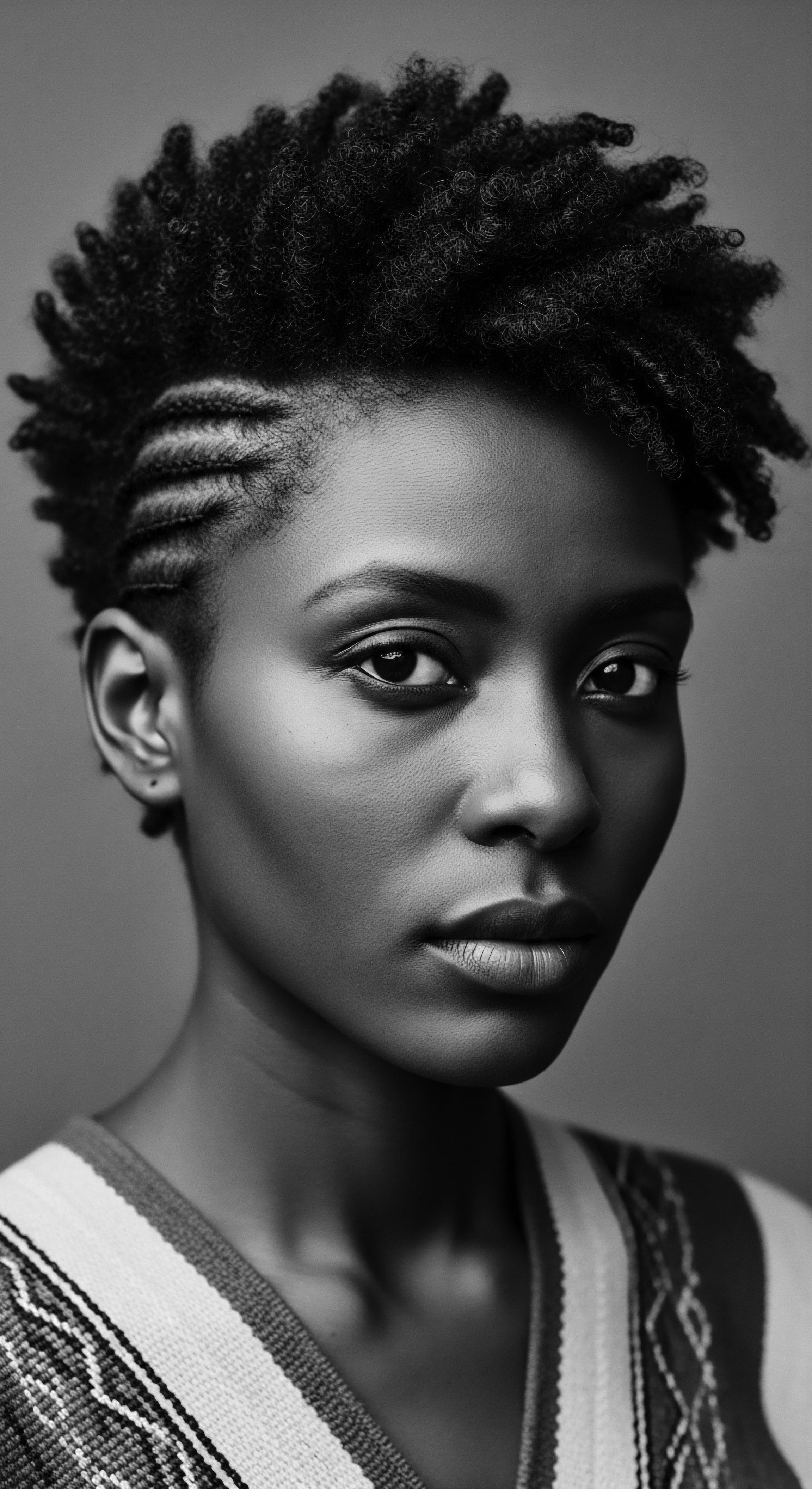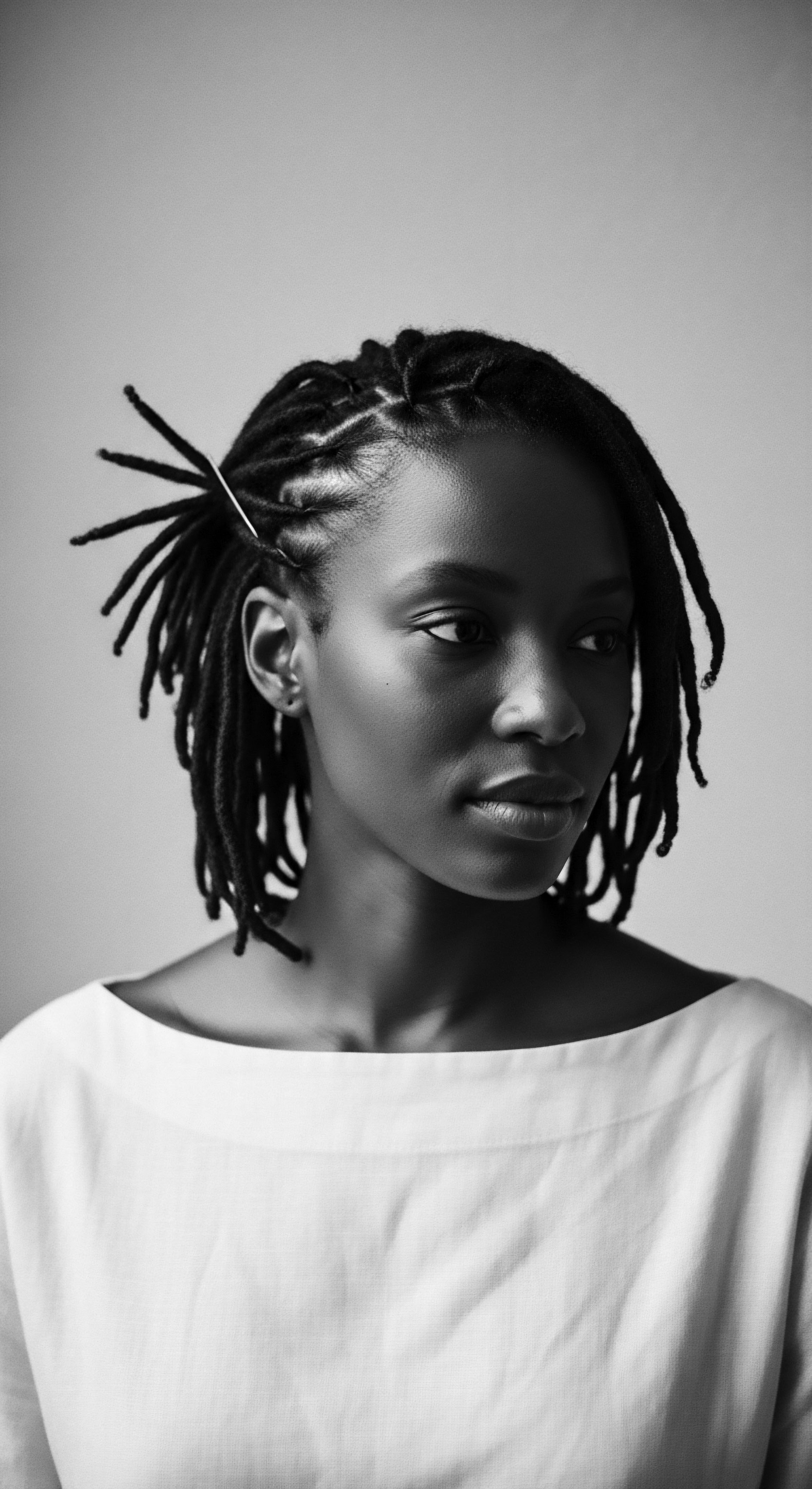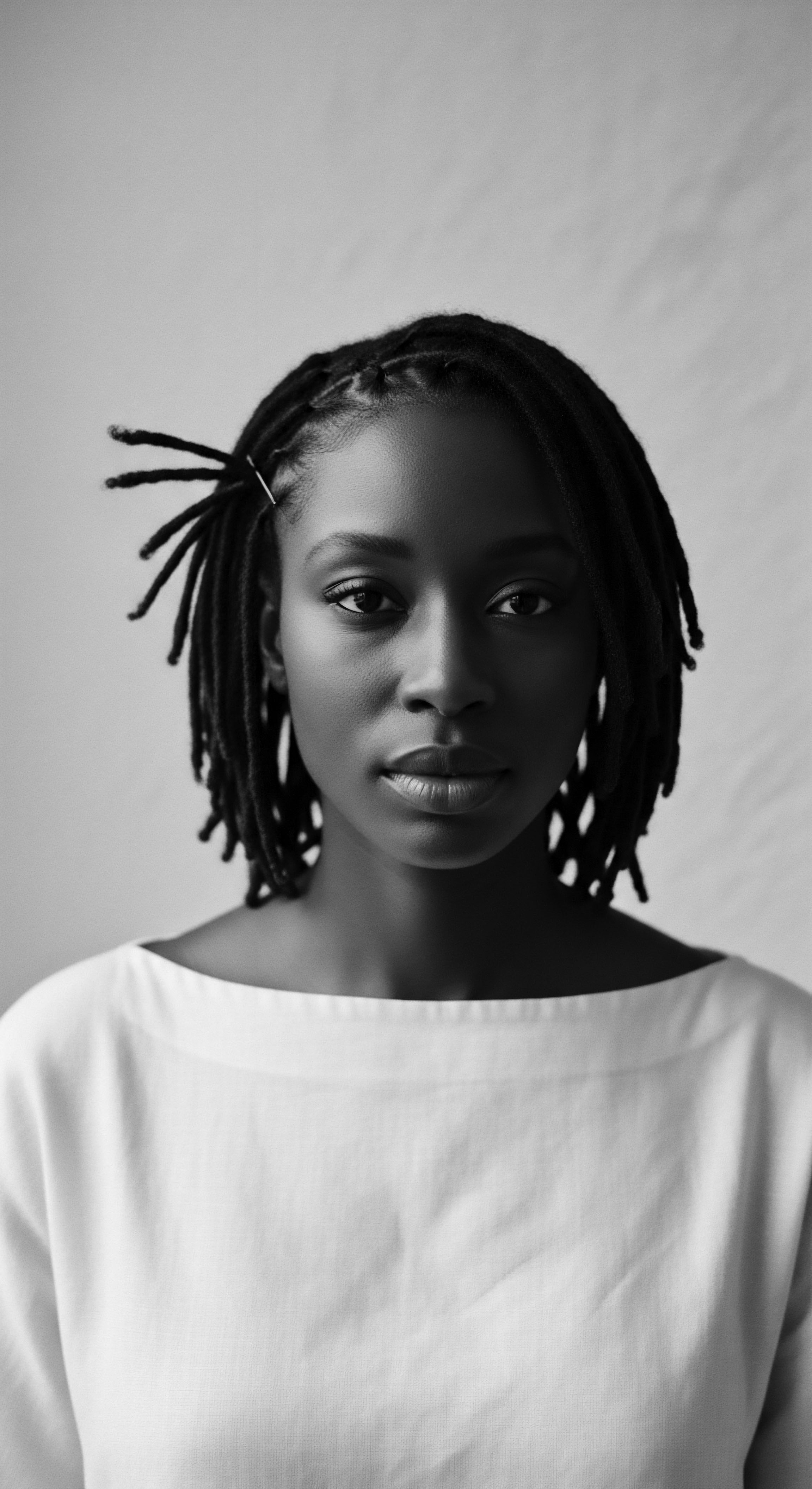
Roots
The very strands that crown our heads hold within them stories echoing across time, particularly for those whose lineage stretches through the vibrant expanse of textured hair heritage. Here, hair color, often dismissed as a superficial trait, unfolds as a profound marker of identity, spirit, and survival. It is a whisper from our ancestors, a visible link to ancient practices and enduring resilience.
We consider the foundational aspects, how the physical reality of pigment converges with deep cultural understanding, illuminating the bedrock upon which the entire narrative of textured hair is built. Our exploration begins at the cellular level, moving outwards to embrace the rich traditional lexicon and the ancestral wisdom that shaped early understandings of hair’s inherent hues and the subtle shifts that distinguish one strand from another.

The Melanin Matrix and Ancestral Echoes
At its core, hair color owes its existence to melanin, a complex group of biomolecules created by specialized cells known as melanocytes. These cells produce two primary types of melanin ❉ Eumelanin, responsible for brown and black shades, and Pheomelanin, which gifts hair its red and yellow tones. The specific balance and distribution of these pigments determine the rich spectrum of natural hair colors present across humanity, with individuals of African descent typically possessing a higher concentration of eumelanin, leading to the deep, varied shades of brown and black hair.
Yet, ancient peoples, without microscopes or biochemical assays, held an intuitive, perhaps even spiritual, grasp of these intrinsic differences. Hair, as the most elevated part of the body, was often considered a conduit to the divine, a portal for spirits to pass through to a person’s soul. The natural color of one’s hair, then, was not merely a biological accident but a signature of one’s spiritual connection, perhaps even a reflection of lineage or a prophecy of one’s destiny.
In many African societies, the variations in hair texture and, by extension, color were observed and held meaning. These observations fostered early systems of classification, not formal scientific categories, but communal understandings tied to social roles, family affiliations, or even geographic origins.
Hair color in textured hair heritage stands as a living chronicle, a physical manifestation of ancestral wisdom and enduring cultural identity.

Pigment as Pedigree and Prophecy
Across various pre-colonial African societies, hair carried messages far beyond simple aesthetics. A person’s hairstyle, and often its natural shade or intentionally altered color, conveyed a wealth of information about their status within the community. This included elements like marital status, age, religious affiliation, social standing, and even specific ethnic identity.
The deep browns and blacks, characteristic of many textured hair types, were not just hues; they were canvases for intricate designs, braids, and adornments that spoke a silent, yet powerful, language. The subtle differences in shade between individuals or families could sometimes be linked to specific ancestral lines or geographic regions, becoming an unspoken pedigree.
For instance, within the Himba tribe of Namibia, the traditional red ochre paste called Otjize, a blend of butterfat, ochre pigment, and aromatic resin, is applied not only to the skin but also to the hair. While this practice creates a distinctive reddish-brown hue, it is more than just coloring. It marks social stages, signifies beauty, and provides protection from the harsh sun, becoming a visual cue of a woman’s readiness for marriage or her status as a new mother. This ancient custom shows that while color might be added, its true significance resides in its role as a marker of life’s journey, an extension of the body’s own history.

Earth’s Palette Ancient Dyes and Rituals
Before synthetic dyes, ancestral communities turned to the earth’s bounty to shift or enhance hair color, often for ritualistic, social, or protective purposes. Plants like Henna (Lawsonia inermis) and Indigo (Indigofera tinctoria) were central to these practices. Henna, yielding reddish-brown shades, and indigo, providing deep blues that can appear black when combined with henna, have histories stretching back millennia in regions across Africa, the Near East, and the Indian subcontinent.
These applications were rarely casual. They were often steeped in ritual, performed during ceremonies, rites of passage, or as part of spiritual observances. The act of gathering and preparing the plant materials, the communal application, and the symbolism of the resulting color were integral to the practice.
- Henna ❉ Sourced from the dried and powdered leaves of the henna plant. Its primary coloring component, Lawsone, binds to keratin in the hair, imparting reddish-brown tones. Beyond color, it was valued for strengthening hair and adding a natural sheen.
- Indigo ❉ Derived from the leaves of the indigo plant, producing a deep blue dye. When used in a two-step process after henna, it creates shades from rich brown to deep black, offering a chemical-free alternative to synthetic dyes.
- Ochre ❉ Various types of natural earth pigments, rich in iron oxides, were used to create red, yellow, and brown tones. Mixed with fats or oils, it served not only as a cosmetic coloring agent for hair and skin but also provided sun protection. The Himba people’s use of Otjize stands as a prime example of its multi-functional role.
These natural pigments were not simply about changing a shade; they were about connecting to the land, affirming identity, and participating in communal life cycles. The knowledge of which plants to gather, how to prepare them, and when to apply them was a profound ancestral wisdom, passed down through generations, ensuring the continuity of these practices.

Ritual
The thread of hair color, spun through the ages in textured hair heritage, moves beyond its biological roots into the realm of deliberate practice—the ritual. Here, the tender touch of care and the profound embrace of community become the canvas upon which cultural significance truly unfolds. Ancestral hands, guided by generations of wisdom, transformed the act of applying color into a ceremony, a communal gathering, or a solitary moment of spiritual connection. This section considers how intentional changes to hair’s natural shade became an integral part of living traditions, a powerful assertion of self and collective memory, particularly against forces seeking to diminish or erase that very heritage.

Ceremony of Shade Identity in Adornment
Hair coloring, through natural means, was deeply intertwined with the ceremonial life of many African societies. It was a visual language, a means of communicating identity, status, and life stages without a spoken word. The precise shade, the method of application, and the accompanying adornments were all imbued with meaning. For instance, a particular hue might signal passage into adulthood, readiness for marriage, or even a period of mourning.
In these contexts, hair color became an active participant in rites of passage, solidifying a person’s place within their lineage and broader community. The communal aspect of hair care, where elders often styled the hair of younger generations, reinforced these bonds, passing down not only techniques but also the stories and meanings associated with each strand.
The Yoruba people, for example, would braid their hair in specific patterns to send messages and communicate with their deities. While the primary focus here was on style, the intentional preparation and sometimes the color enhancement, often with plant-based treatments, contributed to the sacredness of the act. The spiritual importance of hair itself meant that any alteration, including color, carried weight, serving as a conduit for blessings or as a protective measure.

Resisting the Erasure Hair Color as Assertion
The transatlantic slave trade sought to sever the profound connection between African peoples and their heritage, including their hair practices. Forced head shaving was a systematic act designed to strip individuals of their identity, culture, and communal ties, rendering them anonymous chattel. Despite this brutal disruption, the cultural importance of hair endured, often becoming a silent, yet potent, form of resistance. The drive to reclaim visible markers of identity, even subtle ones, was deeply ingrained.
Intentional hair coloring, a practice of deep ancestral roots, stands as a testament to cultural preservation and the enduring spirit of self-definition within textured hair heritage.
In the diaspora, particularly under systems that sought to impose Eurocentric beauty ideals, the use of hair color, even natural applications, evolved into acts of assertion. While historical records detailing specific widespread hair color defiance among enslaved Africans are less explicit than those about hairstyles (like cornrows being used to hide seeds or map escape routes), the very act of tending to one’s hair and body in a way that resonated with ancestral memory was an act of quiet rebellion. As noted by Byrd and Tharps in Hair Story, the desire to conform to European beauty standards often influenced hair practices after emancipation, but a counter-current persisted, seeking to reaffirm Black identity. The preference for certain deep, natural shades of brown or black, perhaps enhanced by traditional remedies, could be seen as an honoring of inherent beauty and a rejection of imposed inferiority.
| Ancestral Context Communal hair dressing as a social bond and knowledge transfer. |
| Significance in Diaspora Hair styling as a private, intimate space for cultural continuity and oral history. |
| Ancestral Context Hair color and styles signifying marital status, age, or tribal affiliation. |
| Significance in Diaspora Hair as a statement of political identity and defiance against assimilation. |
| Ancestral Context Spiritual connections through hair, acting as a conduit to the divine. |
| Significance in Diaspora Hair care products and practices fostering community and economic self-sufficiency. |
| Ancestral Context The journey of hair color from ancient ritual to modern assertion reflects an unbroken line of cultural endurance. |

Generations of Knowledge Passing on the Pigment
The transmission of knowledge regarding hair care, including the art of coloring with natural ingredients, was inherently generational. This was not merely a set of instructions; it was a deeply relational act. Mothers, grandmothers, and community elders passed down the wisdom of identifying plants, preparing the dyes, and applying them with patience and intention.
This process solidified bonds, making hair care a sacred social ritual. Each application of henna or indigo, each careful mixing of ochre, carried the weight of history and the promise of continuity.
This shared wisdom ensured that the cultural meanings associated with specific hair colors and their enhancements remained a living, breathing part of the community’s collective memory. It was a tangible link to a past that colonialism sought to destroy. Even today, echoes of these ancestral practices resonate in the kitchens and parlors where textured hair is lovingly tended, reaffirming that the care and adornment of hair are acts of heritage, rooted in a collective history that refuses to be erased.

Relay
The journey of hair color in textured hair heritage, like a vibrant thread continuously spun, carries the whispers of ancient practices into the bold expressions of the present and the unfolding possibilities of the future. This section moves us from the deeply rooted rituals to the dynamic interplay of reclamation, innovation, and global resonance. Here, the significance of hair color transcends simple adornment; it becomes a powerful vehicle for self-definition, a symbol of collective pride, and a living testament to an unyielding spirit of cultural preservation that constantly renews itself through time. We examine how historical forces shaped, but never extinguished, the profound connection to hair color, leading to contemporary expressions that speak volumes about identity and belonging.

The Modern Kaleidoscope Reclamation and Innovation
The 20th century, especially the Civil Rights and Black Power movements, brought a significant shift in attitudes towards textured hair. The embrace of natural hairstyles, particularly the Afro, became a powerful political statement, a symbol of pride and defiance against Eurocentric beauty standards. Within this movement, the natural color of textured hair—the rich spectrum of browns and blacks, often with undertones of auburn or deep red due to varying melanin concentrations—was celebrated as an inherent part of Black beauty. This was not about adding artificial color, but about affirming the beauty of what naturally grows.
In contemporary times, the relationship with hair color has broadened. While the appreciation for natural hues remains strong, there is also a vibrant exploration of artificial colors. This is not a rejection of heritage but a modern interpretation, a re-imagining of self-expression within the context of a strong cultural foundation. Vibrant blues, fiery reds, and striking greens now adorn textured strands, often used to complement natural curl patterns or elaborate protective styles.
This artistic choice can be seen as an extension of the historical impulse to adorn and signify through hair, now with a wider palette available. It speaks to a modern freedom of expression, built upon the hard-won battles of past generations to define beauty on their own terms.
Hair color in textured hair heritage represents an ongoing dialogue, a vibrant conversation between the wisdom of ancestors and the evolving expressions of a living culture.

Pigment as Protest and Pride
Historically, the pressure to conform to Eurocentric beauty standards led many Black individuals to alter their hair texture through chemical straightening or heat. This was often driven by societal bias, where straight hair was perceived as more professional or acceptable in certain spaces. A 2020 study by Duke University found that Black women with natural hairstyles were perceived as less professional, less competent, and less likely to be recommended for job interviews than candidates with straight hair. This demonstrates the enduring impact of systemic bias on hair perception.
However, the reclamation of natural hair, including its inherent color, has been a sustained act of resistance. It signifies a refusal to adhere to oppressive beauty norms and a declaration of pride in one’s ancestral lineage. The deliberate choice to wear one’s hair in its unadorned, natural state, or to enhance it with colors that reflect personal expression, becomes a profound political and personal statement.
It asserts autonomy over one’s appearance and challenges the lingering stereotypes rooted in historical oppression. The use of color, whether natural or introduced, contributes to this ongoing narrative of self-acceptance and cultural affirmation.

The Global Strand Inherited Hues, New Horizons
The significance of hair color in textured hair heritage extends globally, carried across continents by the African diaspora. What began as localized tribal customs and ritualistic applications of plant-based dyes now finds resonance in diverse communities worldwide. This global movement is powered by increased accessibility to knowledge, both historical and scientific, and a collective desire to reconnect with ancestral practices.
There is a growing interest in traditional ingredients like henna and indigo, not solely for their ability to alter shade, but for their historical connection and perceived holistic benefits, such as strengthening the hair. This represents a return to earlier forms of care, a merging of ancient wisdom with modern wellness philosophies. The understanding of hair’s anatomy and the behavior of melanin, once intuited through generations of observation, is now supported by scientific inquiry, offering a more complete picture of why textured hair responds as it does to color and care.
This combined understanding deepens the appreciation for the ingenuity of historical practices, revealing them not as primitive, but as sophisticated responses to the intrinsic properties of textured hair. The ongoing exploration of hair color, rooted in its profound heritage, continues to shape expressions of identity and community across the world.
- Historical Roots ❉ Understanding that hair, and its natural color, held profound spiritual and social meanings in pre-colonial African societies, signifying everything from tribal affiliation to marital status.
- Colonial Erasure ❉ Recognizing the deliberate attempts during the transatlantic slave trade to strip enslaved peoples of their cultural identity through forced head shaving, which diminished the visible markers of heritage.
- Modern Reclamation ❉ Observing the resurgence of natural hair movements in the 20th and 21st centuries, where wearing natural hair color and texture became a powerful statement of resistance and pride against Eurocentric beauty standards.
- Artistic Expression ❉ Witnessing the contemporary use of a broad palette of colors on textured hair, which, while modern, can be seen as an extension of the historical practice of adorning and communicating identity through hair.

Does Hair Color Genetics Differ Across Textured Hair Types?
The underlying genetic mechanisms that dictate hair color, primarily through the production of eumelanin and pheomelanin, are universal. However, the prevalence and distribution of these melanin types vary across populations, leading to the characteristic deep brown and black shades often associated with textured hair. Studies have indicated that individuals of African ethnicity, for example, tend to have larger melanosomes and higher melanosome density within their hair strands compared to those of Caucasian or Asian ancestry.
These physiological differences contribute to the robust and often rich darkness seen in many textured hair types. The science affirms what ancestral observation already understood ❉ the hair itself holds a unique character shaped by inherited predispositions.

Reflection
To consider the cultural significance of hair color within textured hair heritage is to stand before a living, breathing archive of human experience. Each shade, whether naturally occurring or thoughtfully applied, speaks of profound connections—to the earth’s bounty, to the spirits of ancestors, to the resilience of a people, and to the ever-unfolding narrative of self. The journey from the deep, inherent hues of melanin to the bold statements of modern dyes is not a linear progression from past to present, but a spiraling dance, where ancient wisdom constantly informs contemporary expression. It is a testament to the ‘Soul of a Strand,’ recognizing that our hair is never simply a collection of fibers, but a repository of memory, a canvas for identity, and a vibrant declaration of heritage that continues to shape our present and guide our future.

References
- Byrd, A. D. & Tharps, L. L. (2002). Hair Story ❉ Untangling the Roots of Black Hair in America. St. Martin’s Press.
- Dabiri, E. (2020). Twisted ❉ The Tangled History of Black Hair Culture. Harper Perennial.
- Ortiz de Montellano, B. (1993). Melanin, Mythology, and Mental Illness ❉ A Response to Welsing. Journal of Black Studies, 23(3), 346–355.
- Randle, R. (2015). Hair and Beauty ❉ The History of Black Hair in America. Xlibris Corporation.
- Sherrow, V. (2006). Encyclopedia of Hair ❉ A Cultural History. Greenwood Publishing Group.
- Thompson, S. (2009). Black Women, Beauty, and Power. Routledge.
- Walker, S. (2007). Style and Status ❉ Selling Beauty to African American Women, 1920-1975. University Press of Kentucky.
